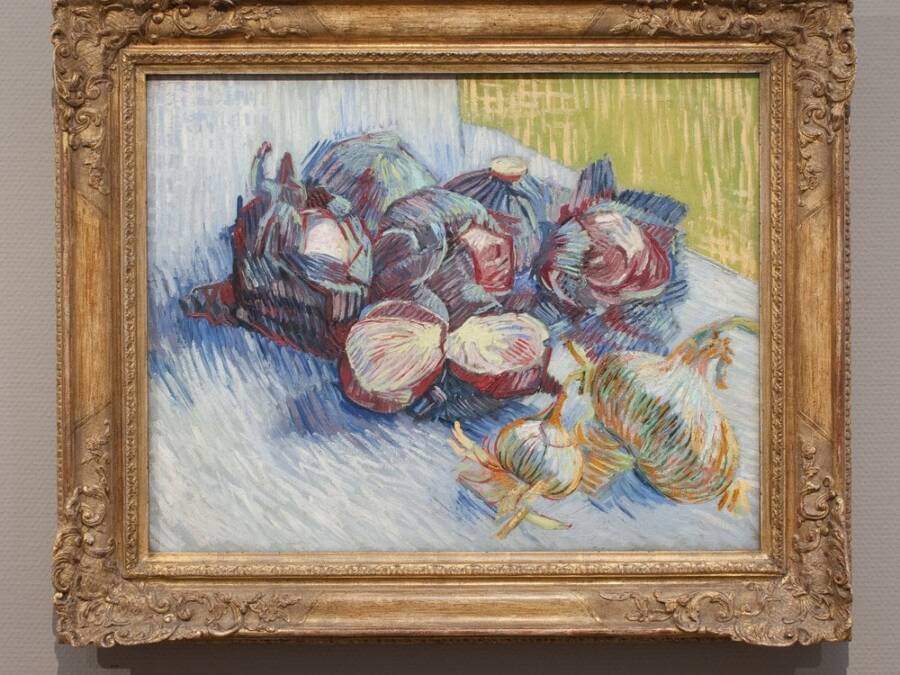Chef and artist Ernst de Witte made a presentation that convinced the Van Gogh Museum's curators to change the name of the Dutch artist's 1887 still life based on the grounds that the allium featured in it had been misidentified.

Wikimedia CommonsThe Vincent van Gogh painting once known as Red Cabbages and Onions.
While visiting the Van Gogh Museum in Amsterdam in March 2022, chef Ernst de Witte noticed something wrong with the Dutch artist’s 1887 still life Red Cabbages and Onions — namely, that the painting did not portray any onions.
Instead, de Witte observed two heads of garlic in the foreground of the painting, despite what the wall label beneath it claimed. And de Witte would know the difference — he’s the head chef of Restaurant Feu in Utrecht, Netherlands, with nearly 20 years of professional kitchen experience.
So, de Witte sent a message to the museum alerting them of the inaccuracy. As he told Hyperallergic, they “took it seriously from the start.”
The Van Gogh Museum requested that de Witte provide proof of this claim. Together with his wife, de Witte created a PowerPoint presentation that compared the 1887 still life with another of van Gogh’s works, Still Life With a Plate of Onions (1889), in which he analyzed the different techniques van Gogh employed with each vegetable.
“And I made a video in which I compared different garlic varieties and onions,” de Witte told Artnet. “I made an overlay drawing on the garlic bulbs in the Van Gogh painting to show that the lines he made actually show the cloves of the garlic.”
De Witte is also a visual artist himself; he took up painting four years ago, a hobby about which he became particularly impassioned during COVID lockdowns when renting a studio space.

Ernst de WitteChef/artist Ernst de Witte with a small sampling of his paintings.
More than two million people visit the Van Gogh Museum each year, and the work previously known as Red Cabbages and Onions has been prominently on display for decades. In fact, it was even on loan to the Stedelijk Museum in Amsterdam for four decades between 1931 and 1973.
Yet, in all that time, no one considered that the posthumous title — which it was given in 1928 — might refer to the wrong kind of allium. That is until de Witte brought it to the attention of museum curators.
After his presentation, the museum brought de Witte’s evidence to its research team and consulted with a biologist. In the end, they agreed with de Witte’s assessment: the still life was, in fact, of cabbages and garlic.
“We constantly monitor our paintings, and it has happened before that a title was changed because something different was depicted than initially thought,” a museum spokesperson said.
The museum then contacted de Witte in November 2022 to inform him that they would indeed be changing the name of van Gogh’s still life.
“It was a euphoric feeling, and also confirmation that I have a chef/painter’s view of things,” de Witte said. “There is a big cross-pollination for me… The painting side of me helps me a lot with my color use and the composition of my dishes.”
Both online and on the museum’s wall text, the painting is now officially titled Red Cabbages and Garlic.
The painting and the experience also inspired de Witte to create a new dish for Restaurant Feu’s menu and his own painting of cabbages and garlic.

Ernst de WitteThe dish at Restaurant Feu in Utrecht inspired by van Gogh’s still life and de Witte’s experience with the museum.
“The dish is poached red cabbage in an oven-roasted garlic bouillon, a crème of smoked garlic, red cabbage coulis, red cabbage powder, and a vinaigrette with absinthe, lemon balm, and tarragon,” he said. “As soon as the vinaigrette comes in contact with the red cabbage components, the colors start to fade, just as the red/blue pigments in van Gogh’s paintings.”
“Our guests are in love with it, especially combined with the story and the beer brewed with absinthe we pair it with.”
After reading about this renamed Vincent van Gogh artwork, read about the other van Gogh — a one-eared dog who paints with his tongue. Or, learn about 11 facts about Vincent van Gogh you might not have known.





